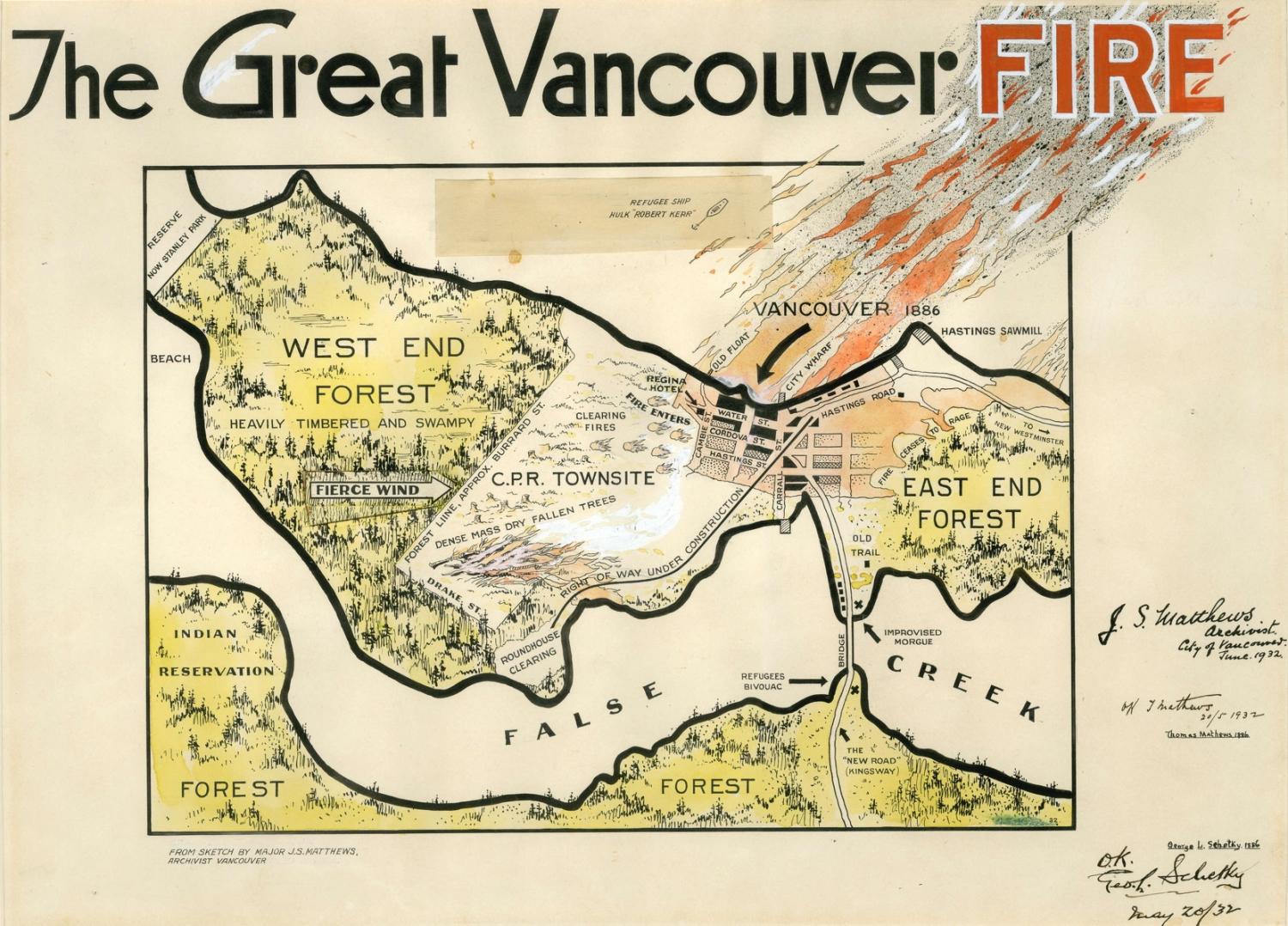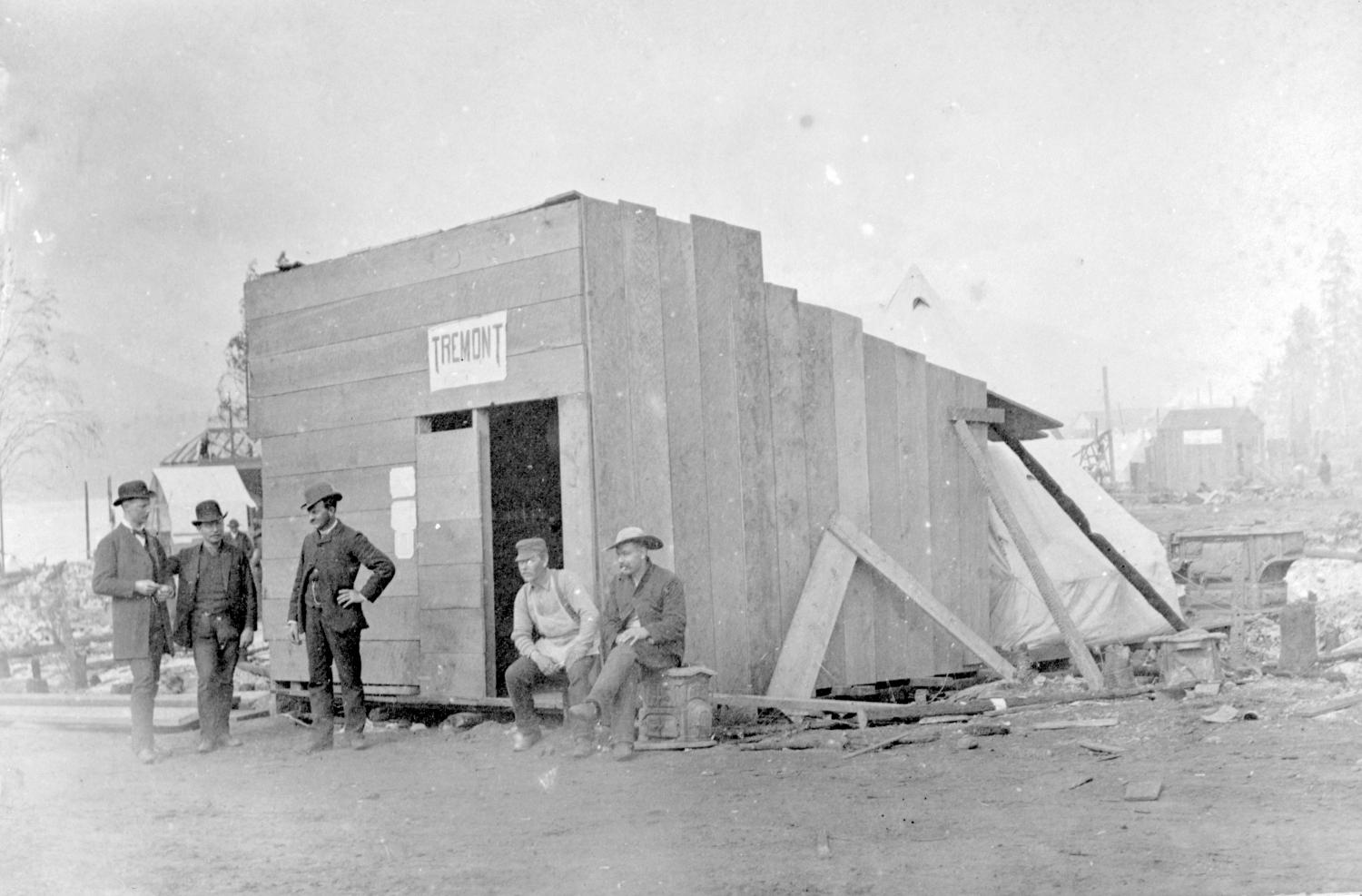The Great Vancouver Fire
Not one year old, an emerging city goes up in flames
Date: 1886
On the morning of Sunday, June 13, 1886, the City of Vancouver was only two months old. The fledgling settlement comprised no more than a thousand buildings on a small pocket of land along the Burrard Inlet, now Gastown and the Downtown Eastside. By that afternoon, only about three buildings still stood. The rest had burnt to a crisp in under an hour.
The blaze started midday when fires burning mill waste spread wildly out of control due to strong winds. According to a newspaper account, the men watching over the clearing fires could do nothing but “flee for their lives.” Minutes later, the whole city was awash in smoke, ash and ember. Most of Vancouver’s buildings had been built with freshly-milled lumber that lit up like tinder. Residents had no time to pack up their lives before heading for safety. According to eyewitness accounts, flames engulfed Vancouver’s wooden sidewalks “faster than a man could run.” The stories that survive that day present a mix of tragedy, compassion and a headstrong determination to trudge on.
As the fire raged across town, choking its residents in smoke, many leapt into the Burrard Inlet to escape the flames. One woman waded above the waves holding her sewing machine, the only item she had managed to save. Others clambered onto boats and makeshift rafts. “On the steamers and wharves, while the city was a mass of roaring flame, were fathered hundreds of frightened and excited men and sobbing women and children,” reported the Vancouver Daily News a few days later. After the vessels had filled up, others could only tread water. Some never made it to the shore at all. A couple of businessmen survived only by burrowing their faces into the gravel. A mother and son were found dead at the bottom of a well.
Agnes Lacket Joe watched the flames lick the sky from across the water on the North Shore. Then the Squamish woman hopped in a long, dugout canoe and hurriedly paddled across the inlet to rescue those who had jumped in the harbour. Fellow Squamish followed behind her. As they rowed towards the shore, they sang a song. And when their canoes were full, they brought the survivors back to their village Eslhá7an and then returned for more. The Squamish community’s act of heroism went mostly unacknowledged for more than a hundred years. But the people they saved didn’t forget. On holidays, they’d break bread with Agnes and other Squamish rescuers, according to one of Agnes’s descendants.
The exact number of people who died that day remains unknown, though dozens are believed to have perished. Most lost their home. On the day of the fire, Mayor Malcolm McLean sent a telegram to Ottawa: “Sir John A. Macdonald. Our city is ashes. Three thousand people homeless. Can you send any government aid?” Money from the federal government did come, along with aid and supplies from the provincial government and a host of towns near and far, including Toronto and Seattle.
The effort to rebuild Vancouver started mere hours after the city burned down. By morning, the skeletons of new buildings already stood amid emergency tents and lingering smoke. Weeks later, the city looked much like it had before the fire, though with considerably more brick-framed buildings. As Vancouver historian Chuck Davis put it: “In 20 minutes, Vancouver had been wiped off the earth. In 12 hours, it was rising again.”
Sources:
1. “Burning of Vancouver.” The Victoria Daily Times, 17 June 1886.
2. Davis, Chuck. The Greater Vancouver Book: an Urban Encyclopaedia. Linkman Press, 1997.
3. “The Fire.” Vancouver Daily News, 17 June 1886.
4. Mackie, John. This Week In History: Vancouver Burns in Great Fire of 1886. The Vancouver Sun, 13 June 2015, vancouversun.com/news/metro/this-week-in-history-vancouver-burns-in-great-fire-of-1886.
5. Matthews, Major James Skitt. Early Vancouver. Volume One, City of Vancouver, 2011.
6. Morley, Alan. Vancouver: From Milltown to Metropolis. Mitchell Press, 1974.
7. Nair, Roshini. City Formally Acknowledges First Nations Who Saved Vancouverites during 1886 Great Fire. CBC News, 15 June 2017, www.cbc.ca/news/canada/british-columbia/city-formally-acknowledges-first-nations-who-saved-vancouverites-during-1886-great-fire-1.4159004.
8. Remembering The Great Vancouver Fire. Gastown Business Improvement Society, 13 June 2018, gastown.org/remembering-the-great-vancouver-fire/.
9. Shepherd, Jeremy. Historic Squamish Rescue Effort Recognized. North Shore News, 15 June 2017, www.nsnews.com/local-news/historic-squamish-rescue-effort-recognized-3053745.
10. Smith, Lisa. Vancouver Is Ashes: The Great Fire of 1886. Ronsdale Press, 2014.







